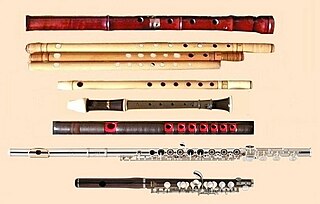
Back Aerophon ALS آلة هوائية Arabic Aerofon Czech Aerophon German Αερόφωνο Greek Aerosonilo Esperanto Aerofonid Estonian آئروفون Persian Aerofoni Finnish Aerofoan Frisian

An aerophone (/ˈɛəroʊfoʊn/) is a musical instrument that produces sound primarily by causing a body of air to vibrate,[1] without the use of strings or membranes (which are respectively chordophones and membranophones), and without the vibration of the instrument itself adding considerably to the sound (or idiophones).[2]
Aerophones or 'air instruments' include what are usually called 'wind instruments,' with the addition of a few instruments with a different acoustical principle called 'free aerophones.'
A wind instrument has two essential factors: a tube enclosing a column of air, and a device for setting that air into vibration by interrupting into pulsations the steady breath of the player (or the wind of a bellows).
These may be lips, a mechanical reed, or a sharp edge. Also, an aerophone may be excited by percussive acts, such as the slapping of the keys of a flute or of any other woodwind. A free aerophone lacks the enclosed column of air yet, "cause a series of condensations and rarefications by various means."
- ^ Cite error: The named reference
Randel 1999 p. 12was invoked but never defined (see the help page). - ^ "aerophone — OnMusic Dictionary". Connect for Education Inc. December 4, 2014. Retrieved December 4, 2014.
- ^ Sachs, Curt (1940). The History of Musical Instruments, p.457 and 459. W. W. Nortan & Company, Inc. ISBN 0-393-02068-1